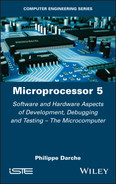Conclusion of Volume 5
The microprocessor lies at the heart of current digital systems. This programmable logic component sequentially executes instructions from a program stored in main memory. The preceding volume addressed the software aspects of this component.
In its opening chapter, this final volume presented the software development chain for a microprocessor system application. The various steps and related tools were examined.
The software and hardware tools for debugging and testing were the subject of the second chapter. Early debugging tools and practices such as postmortem analysis and the iterative burn and learn approach are no longer suitable today. Increasingly complex and fast MPUs require integration of testing and debugging logic as close to operations as possible. Internal debugging (OCD for On-Circuit Debugger/Debugging) and the related communication interfaces such as JTAG (Joint Test Action Group) were then examined. Assembly language, which enables the symbolic manipulation of instructions and variables, was then described in detail. Even though today, High-Level (programming) Languages (HLL) have taken its place in embedded systems thanks to progress in storage and compilers, it is still used in specific cases such as memory and runtime optimization, to interface with the system or hardware, and in teaching computer architecture.
To conclude this final volume, the architectures of the early emblematic microcomputers, that is, the Apple II and the various generations of the PC, were presented. The integration of discrete logic components and then the microcomputer’s subsystems into a chipset occurred progressively, arriving today at a single external component that, in combination with the MPU and main memory, forms an almost complete processing unit. Finally, the firmware aspect was addressed by presenting the BIOS (Basic Input/Output System) and the (U)EFI ((Unified) Extensible Firmware Interface) for the PC (Personal Computer).
A subsequent work will address the next generation, which corresponds approximately to the 1980s and 1990s. This will include 16/32-bit and RISC-type (Reduced Instruction Set Computer) microprocessors. Two important concepts relating to memory were introduced in these systems, namely virtual and cache memory. Another major aspect introduced in these processors was Instruction-Level Parallelism (ILP) with pipelined and superscalar architectures. The final book will discuss multicore technology.
NOTE.– The concepts introduced in this work will be completed in relation to newer releases in future works by the author.
